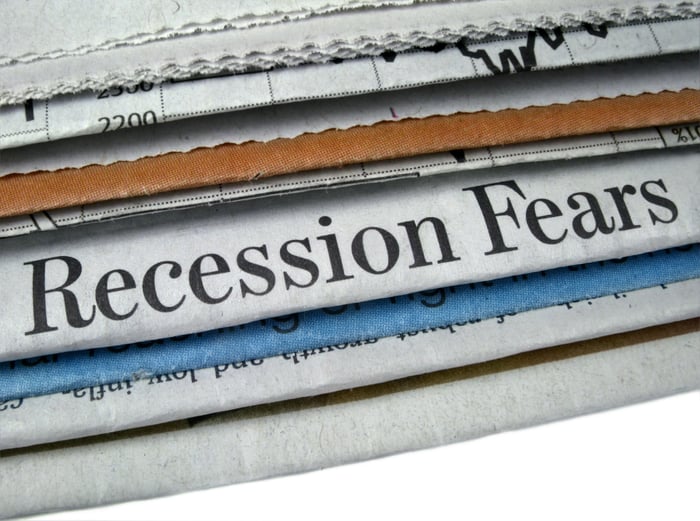Over long periods, Wall Street is an undisputed wealth creator. On an annualized basis, stocks have outpaced the returns for oil, gold, housing, and even Treasury bonds. But broader market returns get a lot dicier when the timeline being examined is in months or spans just a few years.
Since the start of 2020, the ageless Dow Jones Industrial Average (^DJI 0.40%), widely followed S&P 500 (^GSPC 1.02%), and growth-dependent Nasdaq Composite (^IXIC 2.02%), have vacillated between bull and bear markets. Although all three major indexes have rallied meaningfully off of their 2022 bear market lows, questions remain as to what's next for Wall Street.

Image source: Getty Images.
While no economic datapoint or predictive indicator can, with 100% accuracy, always forecast directional moves in the broader market, a handful of metrics and tools do have uncanny correlations with moves in the Dow Jones, S&P 500, and Nasdaq Composite. One such tool, which hasn't been wrong under certain conditions for the past 70 years, has a very clear and sobering message of what's to come for Wall Street.
Under certain parameters, this economic tool has a flawless predictive history spanning seven decades
For the everyday investor, there are an overwhelming number of economic datapoints to keep track of. But the one metric that tends to draw a lot of attention is the U.S. ISM Manufacturing New Orders Index, which is a subcomponent of the even more-popular ISM Manufacturing Index (also known as Purchasing Managers' Index, or PMI).
The ISM Manufacturing New Orders Index surveys new order activity within the industrial sector and is reported on a monthly basis. Even though the industrial sector isn't the juggernaut it once was for the U.S. economy decades ago, it's still a fairly accurate gauge of the health of the U.S. economy.
The ISM Manufacturing New Orders Index ranges from 0 to 100, with 50 serving as the baseline where industrial order activity is neither expanding nor contracting. A figure above 50 represents expansion of industrial ordering activity, while a number below 50 signals industrial order contraction.
US ISM Manufacturing New Orders Index data by YCharts.
In October, the Institute for Supply Management (the "ISM" in the ISM Manufacturing Index) reported that the ISM Manufacturing New Orders Index came in at 45.5, signaling contraction. This marked the 14th consecutive month where this indicator has come in below 50.
Perhaps even more interesting is what happens to the U.S. economy when the U.S. ISM Manufacturing New Orders Index signals contraction. Though there have been plenty of instances where this tool has dipped below 50 over the past seven decades, a decline below a reading of 43.5 has always been a precursor to a U.S. recession since the early 1950s. There have been two readings below this figure over the past year.
To be clear, I'm not saying the U.S. ISM Manufacturing New Orders Index can precisely time when an economic downturn will occur. I'm merely pointing out that 43.5 has been a line-in-the-sand precursor to an eventual U.S. recession for seven decades.
This is noteworthy for Wall Street given that the S&P 500 has endured approximately two-thirds of its peak-to-trough drawdowns after, not prior to, the official declaration of a U.S. recession. In other words, if history rhymes, once more, the Dow, S&P 500, and Nasdaq Composite could be headed meaningfully lower.

Image source: Getty Images.
Here's why smart investors are looking to the horizon
To be fair, the U.S. ISM Manufacturing New Orders Index is far from the only datapoint or indicator signaling trouble for the U.S. economy and stock market. In particular, following the money suggests there could be reasonable downside to come in stocks.
But even with these concerns in mind, smart investors are looking to the horizon and allowing time to be their ally.
When examined agnostically, downturns are a normal and inevitable part of the economic cycle. Something else that's perfectly normal is a quick resolution to recessions. In the 78 years since World War II ended, there have been 12 recessions. Just three of these 12 downturns lasted 12 months, with none of the remaining three surpassing 18 months.
By comparison, most of the economic expansions that followed recessions have endured multiple years. In fact, the period of expansion that was halted by the two-month COVID-19 recession in 2020 lasted longer than a decade. The key point being that the periods of expansion last disproportionately longer than recessions.
Here's the kicker: This disproportionate optimism also translates to Wall Street. Though the stock market and U.S. economy aren't tied at the hip, steady growth in the economy over time should lead to an uptick in corporate earnings. As profits expand, so will equity valuations.
It's official. A new bull market is confirmed.
-- Bespoke (@bespokeinvest) June 8, 2023
The S&P 500 is now up 20% from its 10/12/22 closing low. The prior bear market saw the index fall 25.4% over 282 days.
Read more at https://t.co/H4p1RcpfIn. pic.twitter.com/tnRz1wdonp
Five months ago, Bespoke Investment Group unveiled a dataset that compared the average length of bull and bear markets in the S&P 500 dating back to the start of the Great Depression in September 1929. Whereas the average bear market lasted 286 calendar days, the typical bull market was 3.5 times longer (1,011 calendar days).
A separate analysis from Bank of America Global Research provides even more evidence that thinking long-term is a winning strategy. Researchers examined the probability of generating negative returns in the S&P 500 based on a variety of holding periods, dating back to 1929. The end result was a perfectly inverse correlation between the probability of negative returns and time.
For example, hypothetically holding an S&P 500 tracking index for one day, three months, or one year, would have produced a 46%, 32%, and 25% respective probability of negative returns over the past 94 years. Meanwhile, holding this position for 10 years or 20 years would have yielded a negative return 6% and 0% of the time, respectively. You're reading that correctly: Holding an S&P 500 tracking index for 20 years has been a moneymaking investment 100% of the time.
No matter what the U.S. economy has in store for Wall Street in the weeks and months to come, patient investors are well-positioned for success.





